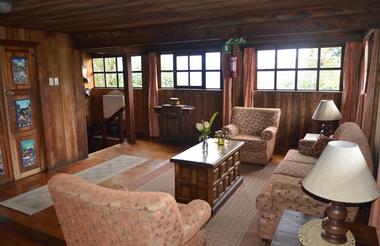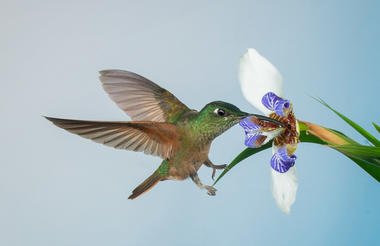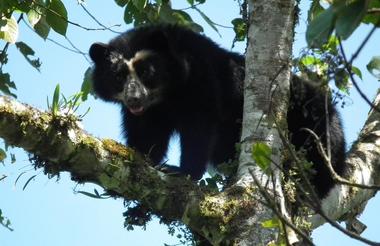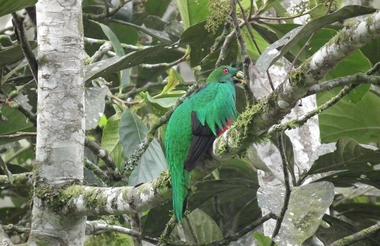We will pick you up in Quito and head first to Yanacocha, which is right outside the northwestern corner of the city. Yanacocha is a huge reserve protecting the Black-breasted Puffleg, which is a small hummingbird endemic to the flanks of the Volcano Pichincha overlooking Quito. We can walk the main trail to its end, which may provide us with an opportunity to photograph the puffleg or other birds along the trail, or we can focus solely on the bird feeders near the parking lot. The banana feeders attract Mountain-Tanagers, Brushfinches, a pair of Andean Guans and more! The hummingbird feeders are filled with hummingbirds we will not see elsewhere so we will plan on spending ample time here. The mid afternoon tends to get foggy, and sometime after lunch we will continue on to our hotel to get settled in. After settling in, we will have the option of relaxing at their feeders with our cameras or taking a walk to look for other things to photograph like orchids or birds that won’t come to the feeders. At night we will do a walk looking for insects, frogs and lizards to photograph. Night walks will be offered each night when it isn’t raining.



Lunch
Dinner
Specialized Photography Birding Guide
Silanche and Rancho Suamox are both lowland Chocoan sites. The first is a 60 hectare fragment of remnant forest (30 years ago there were over 20,000 connected hectares there before heart of palm plantations moved in), which is packed full to the brim with birds. The flocks, if found, may contain over 30 to 40 species easily. There is an observation tower near the parking lot where we will focus our time in the reserve to see if we can get photographs or birds coming close to the tower. After some time in Silanche, we will head to Rancho Suamox which is set up better for photography. The Ranch operated as a hotel and the property, like the surrounding properties, was highly manipulated / disturbed. The owners have been reforesting the property and focusing on making the place as bird-friendly as possible. A walk around the property may yield some surprises as they have resident Spectacled Owls among other delights. We will have lunch in Pedro Vicente Maldonado and continue on towards Milpe. Silanche and Rancho Suamox are below 500 m.a.s.l. and Milpe is around 1000 m.a.s.l. meaning the first two are lowland Choco sites and Milpe is a foothill birding site, where we have a good chance of photographing toucans with some patience and lots of foothill hummingbirds!



Rancho Suamox
Milpe
Breakfast
Lunch
Dinner
Specialized Photography Birding Guide
A retired guide (named Vinicio) bought a nice piece of land and made it very bird-friendly in the Birdwatcher’s House. We will get there early in order to take full advantage of the light setup which attracts insectivorous birds, which can be quite difficult to see, out into the relative open. There is also a banana feeder station and hummingbird station. Some of the main targets to photograph are Plate-billed Mountain Toucan, Yellow-breasted Antpitta, Gorgeted Woodstar, and Blue-capped Tanager. We’ll return to our hotel after a long morning of photographing birds. An optional flower macro workshop will be offered or we can focus on hummingbird photography.



Birdwatcher´s House
Breakfast
Lunch
Dinner
Specialized Photography Birding Guide
This morning is a real treat. We will be visiting one of the best cock-of-the-rock leks in the country and we don’t want to be late. Darker clothing is best today. After the show is put on by the Cocks of the Rock, we will start looking for other stars of the morning. Wild antpittas and other birds (like Blue-winged and Black-chinned MountainTanagers, Toucan Barbet, Sickle-winged Guan, Crimson-rumped Toucanet) will hopefully present themselves with astonishing ease. After antpitta time, we will focus in on hummingbirds and fruit feeders while having some traditional food ourselves. After eating our second breakfast, we will head to the place with the world’s highest list of hummingbirds in the world. Tony Nunnery is a North American who reforested a field many years ago with hummingbird friendly plants and made his home there. His home happens to be at the right elevation for truly impressive hummingbird diversity and his land borders the large reserve Bellavista. We can also visit Bellavista Lodge but the photography is better at Tony’s.



Breakfast
Lunch
Dinner
Specialized Photography Birding Guide
The morning’s main target is the charismatically strange Long-wattled Umbrellabird. If we are in the right spot at the right time, then we will have a decent chance of photographing the very strange and charismatic Long-wattled Umbrellabird, so we will set out early today. 23 de Junio is a small community, with a few members constantly monitoring the activity of these critically endangered birds. This constant effort has converted the community’s land into one of the most successfully areas for finding and photographing the rare bird. After visiting the Umbrellabird, we will head back to our hotel briefly, and, then descend into the touristically-famous Mindo Valley. Here we will have lunch and visit a new garden with a new feel to it and maybe some new subjects to photograph or we can visit an orchid garden ideal for practicing macro photography. Afterwards, we can look for Sunbittern or other large charismatic birds to photograph along the Mindo River.



Breakfast
Lunch
Dinner
Specialized Photography Birding Guide
Mashpi Amagusa is a very wet cloud forest. The reserve borders National Geographic’s featured elite Mashpi Lodge. The birding is actually better in Amagusa then it is inside the pristine forest protected by the lodge, who does not cater to birders or wildlife photographers. We will spend some time walking the road, looking in particular for larger pretty birds that don’t go into feeders like Orange-breasted Fruiteater and Rose-faced Parrot. The star attraction here are the banana feeders which attract several rare and pretty birds like Glistening-green Tanager, White-throated Quail Dove, Rufous-throated Tanager, and Moss-backed Tanager. If we are lucky and pacient they may also attract mammals, such as a resident Tayra. After we leave Amagusa and have lunch, we will head to an easy-to-access ravine where oilbirds call home. After photographing these truly unique birds (they are the only nocturnal frugívoros birds and use echolocation to navigate), we will start heading back to the hotel where we will have one last night walk opportunity.



Breakfast
Lunch
Dinner
Specialized Photography Birding Guide
The area right around our hotel is quite birdy, especially in the morning. Once there is enough light for photos, we will head outside and check the activity by the parking lot lights. These lights attract lots of insects and the birds have an easy meal. Hopefully, we will have a diverse cast of birds like Woodcreepers, woodpeckers, flycatchers and more come in to where we are standing with our cameras. Aracaris and tanagers are accompanied by Euphonias and more at the plaintain feeders. We will load up and start back towards Quito in the late morning so we can spend time in Alambi Reserve before finishing up our adventure. Alambi is a really good site for photographing hummingbirds, White-capped Dipper. When avocados are in season, Alambi is the best place around for Quetzals. After our visit to Alambi Reserve, we will head back to Quito and drop the group off at either a hotel or the airport.



Breakfast
Specialized Photography Birding Guide








